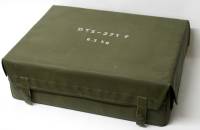Inhaltsverzeichnis
IMFS
Integrated Military Telecommunications System; components manufactured by Plessey, configuration by Ascom.
Since 1993, the IMFS has formed a military telecommunications network independent of the civilian structures; individually configurable switches, to which all possible telephone systems from modern digital stations to olf fashionned field telephones with crank inductors can be connected, thanks to various plug-in cards, are interconnected in a nationwide network structure.
Technical data
- Principle: digital a-hierarchical telecommunications system
- Operation modes: Telephony, data transmission
Power supply
- Batteries: 28 V via mains supply unit
Dimensions
Accessories
- Subscriber station DTS from Ascom
Material
The core components of the IMFS are the „Multi Role Switches“ made by Plessey, the sets have space for 23 plug-in cards: The communications exchange can be configured with 16 plug-in cards for various applications.
Typical configurations are communication exchanges. for example:
- KP - exchange used in command posts: many subscribers, few bundles
- Node - exchange for network nodes: few subscribers, many bundles
- Small - exchange: few participants, few bundles
Five host cards can be inserted in each exchange (processor and memory cards), plus 16 freely configurable addional plug-in cards:
- Bundle cards: 60 channels can be transmitted using a data stream of 2048 kbit/s
- Subscriber cards: for connecting the telephone line subscribers
- MDTI: digital subscriber station on two-wire line
- MDVT: digital subscriber station on four-wire line
- MALM: analogue subscriber stations with tone or pulse dialling
- MMAG: analogue subscriber station with local battery and inductor call (field telephone)
- MPTT: Connection to an analogue exchange line interface, for the transition to the civil / PTT network
All exchanges are powered with 28 V DC from a power supply unit; backup batteries allow uninterrupted operation in the event of a power failure lasting for up to two hours.
The subscribers are assigned a seven-digit telephone number consisting of a five-digit network number and a two-digit subscriber number. With a radio connection point, a connection between IMFS and the modern digital radios SE-135/SE-235 is possible (CNRI, Combat Net Radio Interface).
 The standard device is the Digital Subscriber Station (DTS), which is connected to the exchange with a two-wire line with a maximum length of 6 km; each DTS has a V-24 data interface with which digital data can be transmitted.
The standard device is the Digital Subscriber Station (DTS), which is connected to the exchange with a two-wire line with a maximum length of 6 km; each DTS has a V-24 data interface with which digital data can be transmitted.
All trunked connections are encrypted using the CZ-1 crypto unit; the voice information is still available in the exchanges as an analogue signal. In order to realise end-to-end encryption, the „Variocrypt“ terminal is used; both call participants identify themselves with a chip card.
All the microwave relay connections and the crypto units can be remote controlled from the communication exchanges. The control commands are transmitted as ASCII commands over a remote control interface via the service communications channel.
Technical principle
Components
The system is designed completely in semiconductor technology.
Development
After preliminary work from the 1960s to the 1980s, the concept of an „Integrated Military Telecommunications System“ was initially postponed and relaunched at the beginning of the 1990s.
Based on the „Multi Role Switch „ developed by Plessey, an independent military communications network was initially set up in a pilot test, in which various nodes with a „Multi Role Switch“ worked together in a network-like manner. The electronic switches are largely freely configurable by plugging in different plug-in cards and can be set up and networked according to the role in the network and the main tasks and functions used.
A mesh or grid network secured in accordance with the NATO EUROCOM standard was developed, in which the connections between the individual network nodes, the exchanges, are secured by means of wire connections or wireless microwave relay bundle connections. If connections between individual nodes are damaged due to natural disasters or hostilities, the message or communication can be forwarded via alternative routes in the network, similar to the route that data takes on the internet - the network nodes or intermediaries are equivalent, i.e. they are not based on a higher-level control centre, so we can speak of an non-hierarchical network.
Use
IMFS systems are assigned to the army corps, divisions and brigades to cover their own communication needs. Connections to neighbouring troop units are possible via gateways.

